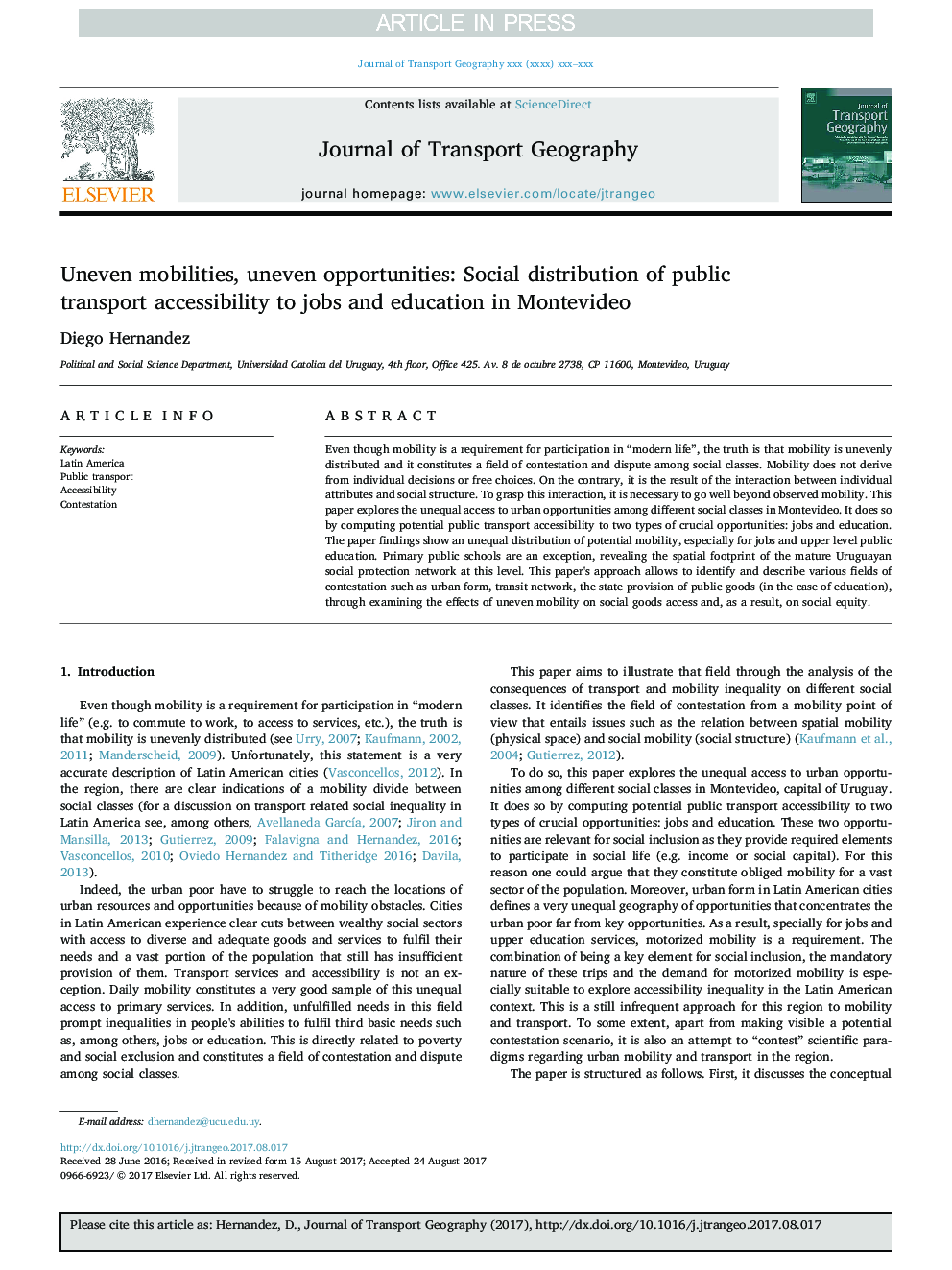| کد مقاله | کد نشریه | سال انتشار | مقاله انگلیسی | نسخه تمام متن |
|---|---|---|---|---|
| 7485120 | 1485400 | 2018 | 7 صفحه PDF | دانلود رایگان |
عنوان انگلیسی مقاله ISI
Uneven mobilities, uneven opportunities: Social distribution of public transport accessibility to jobs and education in Montevideo
ترجمه فارسی عنوان
توانایی های غیرمستقیم، فرصت های ناهموار: دسترسی اجتماعی به مشاغل عمومی و آموزش در مونته ویدئو
دانلود مقاله + سفارش ترجمه
دانلود مقاله ISI انگلیسی
رایگان برای ایرانیان
کلمات کلیدی
آمریکای لاتین، حمل و نقل عمومی، دسترسی، مخالفت،
ترجمه چکیده
گرچه تحرک لازم برای مشارکت در یک زندگی مدرن است، حقیقت این است که تحرک غیرمستقیم توزیع شده است و زمینه شکایات و اختلاف میان طبقات اجتماعی را تشکیل می دهد. تحرک از تصمیمات فردی یا انتخاب های آزاد حاصل نمی شود. برعکس، این نتیجه تعامل بین صفات فردی و ساختار اجتماعی است. برای درک این تعامل، ضروری است که فراتر از تحرک قابل مشاهده باشد. این مقاله به بررسی دسترسی نابرابر به فرصت های شهری در میان طبقات مختلف اجتماعی در مونته ویدئو می پردازد. این کار را با محاسبه دسترسی بالقوه حمل و نقل عمومی به دو نوع فرصت حیاتی: شغل و آموزش و پرورش انجام می دهد. یافته های این مقاله نشان می دهد که توزیع نابرابر از تحرک بالقوه، به ویژه برای مشاغل و تحصیلات عالی سطح بالا. مدارس دولتی عمومی یک استثنا هستند، که نشان دهنده فضای مکانی شبکه محلی محافظت از جمعیت بالغ اروگوئه در این سطح است. این رویکرد مقاله به شناسایی و توصیف زمینه های مختلف اختلاف نظر مانند فرم شهری، شبکه حمل و نقل، ارائه خدمات دولتی کالاهای عمومی (در مورد آموزش و پرورش) کمک می کند، از طریق بررسی اثرات تحرک نامناسب بر دسترسی به کالاهای اجتماعی و در نتیجه ، بر عدالت اجتماعی.
موضوعات مرتبط
علوم زیستی و بیوفناوری
علوم محیط زیست
علوم زیست محیطی (عمومی)
چکیده انگلیسی
Even though mobility is a requirement for participation in “modern life”, the truth is that mobility is unevenly distributed and it constitutes a field of contestation and dispute among social classes. Mobility does not derive from individual decisions or free choices. On the contrary, it is the result of the interaction between individual attributes and social structure. To grasp this interaction, it is necessary to go well beyond observed mobility. This paper explores the unequal access to urban opportunities among different social classes in Montevideo. It does so by computing potential public transport accessibility to two types of crucial opportunities: jobs and education. The paper findings show an unequal distribution of potential mobility, especially for jobs and upper level public education. Primary public schools are an exception, revealing the spatial footprint of the mature Uruguayan social protection network at this level. This paper's approach allows to identify and describe various fields of contestation such as urban form, transit network, the state provision of public goods (in the case of education), through examining the effects of uneven mobility on social goods access and, as a result, on social equity.
ناشر
Database: Elsevier - ScienceDirect (ساینس دایرکت)
Journal: Journal of Transport Geography - Volume 67, February 2018, Pages 119-125
Journal: Journal of Transport Geography - Volume 67, February 2018, Pages 119-125
نویسندگان
Diego Hernandez,
